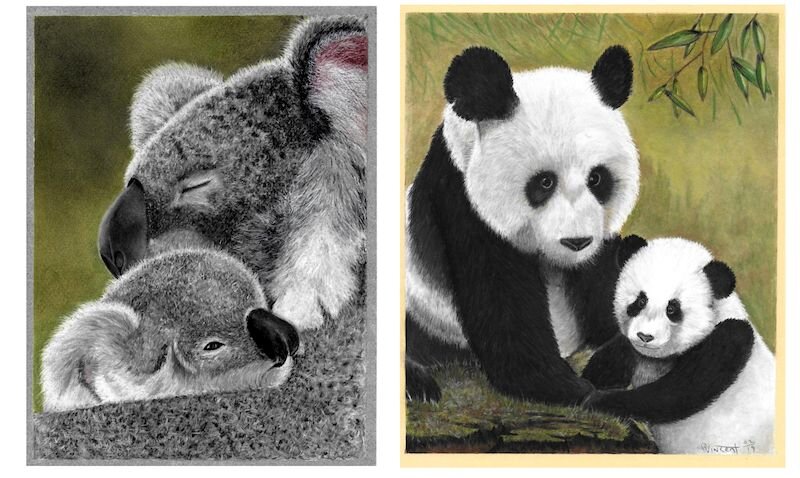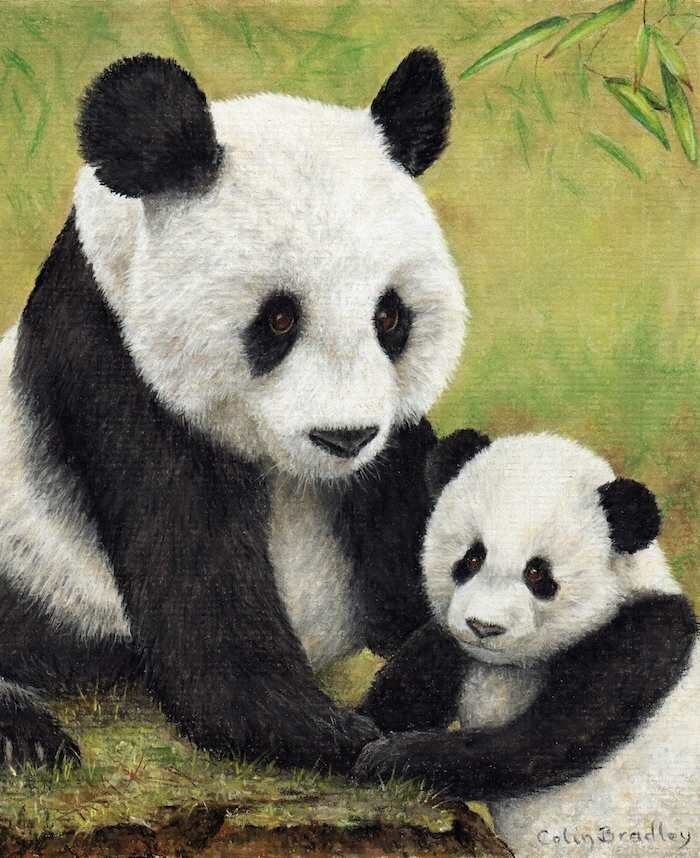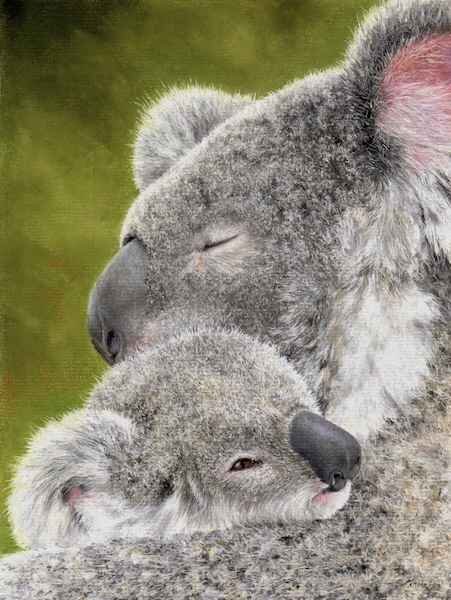Tips for Blending White and Black Animal Fur with Pastel Pencils
Paul sent us a couple of his pictures that he has completed from our online courses - the Koala and Pandas. You too can learn how to draw these pictures and receive feedback on your work by joining our membership.In this post we had the opportunity to discuss animal fur as this is what Paul struggled with. In particular, transitioning white and dark animal fur. See Paul's pictures below along with our recording to listen to. If you would rather read the advice we have included a transcription of the episode as well.
Transcription
Stephen Bradley: Hi Paul. Thanks for sending over your picture Dad and I are here say Hi Dad.Colin Bradley: Hi Dad.Stephen Bradley: Haha! I fell for that one didn't I? Paul you've sent in two of your pictures - the koala bears and the pandas and so we thought we would record a little bit of advice. Use it as an opportunity to talk about a couple of points. So you say "hi Steve and Colin. I just finished this piece and I thought I would send it in for feedback. I've been thinking about it for a long time and never had the courage to give it a go. I think it's a wonderful picture and I hope I've done a decent job of it. I used the Mi-Teintes steel grey (this is the koala bears that he did that on). I found the fur really difficult especially the white on the mother's cheek. I found that quite daunting. I've also sent in my last picture that I've done which was also very difficult. The fur again but I think it's not too bad an effort. This one I did on the Buttercup pastelmat I'm getting to really like this surface and the different colours are fab. Anyway I hope you liked them as much as I did painting them. Many thanks." Well we do like them Paul we love them we think you've done a great job.Colin Bradley: I agree totally.Stephen Bradley: And Paul says that he had a trouble with the white fur on the mother's cheek but he seems to have done it.  Colin Bradley: Yes he has and to be honest when I first looked at it I thought "how can I help?". What we can help with in not just this picture but all pictures is pay attention to the transitions. This is for instance you have white then you have black now white and black together would be too much of a contrast. But what you do is you do white, off white, grey then darker grey then black. See what I mean? So what you're doing then is the transition.Now that's got to be much more subtle than I've just given it there. But you've got to have that in your mind when you're doing it. This is what creates the round ness or the 3 dimensional aspect. And this is where probably Paul is now at because he can do the fur even though I know it's tough. I mean I struggle at times Steve. Everybody does. To do fur any way you've got two things to remember. One is you've got to represent the fur so that people looking at it can see what it is. The other thing you've got to do if you're too accurate. If every single stroke of the pencil and it goes in, it looks too false and it certainly wouldn't be accurate because fur is much thinner and finer than that. So what you have to do is somewhere between the two you have to create the sense of reality if you can but you've also got to try to work out so that rather than doing one single stroke you're doing a hundred strokes in one and that can be done and achieved with the pencil more accurately than it can with a paint brush to be honest.And then you've got the colour shapers which help enormously because once you put that on even though it might look a little bit false when you use the colour shaper on it, it kind of smooths it down a bit so you can you can use all those tools to create the effect you have got there and we're talking about both the koala and the panda. We're talking black and white and black is hard anyway and white is hard anyway and so you put the two together and you've got the problems that Paul had. It's not so bad when you got coloured fur you've got you've got different colours you can use the black and white is hard but I think looking at those pictures you've got nothing to worry about at all. Just keep at it. Do more of them.One of the things I do and always done if there's a picture or a kind of picture that I've, you know, had hesitation with, I do more of them deliberately so that I get more practice at it. And this is what you need to do. So anyway I hope that works for you. I certainly think and I totally agree with Steve that they are really good.
Colin Bradley: Yes he has and to be honest when I first looked at it I thought "how can I help?". What we can help with in not just this picture but all pictures is pay attention to the transitions. This is for instance you have white then you have black now white and black together would be too much of a contrast. But what you do is you do white, off white, grey then darker grey then black. See what I mean? So what you're doing then is the transition.Now that's got to be much more subtle than I've just given it there. But you've got to have that in your mind when you're doing it. This is what creates the round ness or the 3 dimensional aspect. And this is where probably Paul is now at because he can do the fur even though I know it's tough. I mean I struggle at times Steve. Everybody does. To do fur any way you've got two things to remember. One is you've got to represent the fur so that people looking at it can see what it is. The other thing you've got to do if you're too accurate. If every single stroke of the pencil and it goes in, it looks too false and it certainly wouldn't be accurate because fur is much thinner and finer than that. So what you have to do is somewhere between the two you have to create the sense of reality if you can but you've also got to try to work out so that rather than doing one single stroke you're doing a hundred strokes in one and that can be done and achieved with the pencil more accurately than it can with a paint brush to be honest.And then you've got the colour shapers which help enormously because once you put that on even though it might look a little bit false when you use the colour shaper on it, it kind of smooths it down a bit so you can you can use all those tools to create the effect you have got there and we're talking about both the koala and the panda. We're talking black and white and black is hard anyway and white is hard anyway and so you put the two together and you've got the problems that Paul had. It's not so bad when you got coloured fur you've got you've got different colours you can use the black and white is hard but I think looking at those pictures you've got nothing to worry about at all. Just keep at it. Do more of them.One of the things I do and always done if there's a picture or a kind of picture that I've, you know, had hesitation with, I do more of them deliberately so that I get more practice at it. And this is what you need to do. So anyway I hope that works for you. I certainly think and I totally agree with Steve that they are really good. Stephen Bradley: The White as well white fur has generally got other tones in it as well isn't it? So it's got grey and things like that. So it's not just white and dark is it? It's white with speckles of dark grey and light grey and things like that.Colin Bradley: And I think with the fact that you've had these hiccups what you need to do is to look at as many pictures of mine that I've done and there's a lot of them with white fur and dark fur and see with each picture how I've created that effect and it will help you because once you've got it in your head you think "ah I see" and when you're going through them all of a sudden you'll have a light bulb moment and think "Oh right! That's how it's done!" and then you know you're on your way.Stephen Bradley: Building your experience up.Colin Bradley: Absolutely.Stephen Bradley: Okay Paul I hope that's helped and other people listening as well with their fur and we'll see you on the next episode. Thanks.We hope you found this post helpful, if you did, drop us a comment below! ????????
Stephen Bradley: The White as well white fur has generally got other tones in it as well isn't it? So it's got grey and things like that. So it's not just white and dark is it? It's white with speckles of dark grey and light grey and things like that.Colin Bradley: And I think with the fact that you've had these hiccups what you need to do is to look at as many pictures of mine that I've done and there's a lot of them with white fur and dark fur and see with each picture how I've created that effect and it will help you because once you've got it in your head you think "ah I see" and when you're going through them all of a sudden you'll have a light bulb moment and think "Oh right! That's how it's done!" and then you know you're on your way.Stephen Bradley: Building your experience up.Colin Bradley: Absolutely.Stephen Bradley: Okay Paul I hope that's helped and other people listening as well with their fur and we'll see you on the next episode. Thanks.We hope you found this post helpful, if you did, drop us a comment below! ????????

